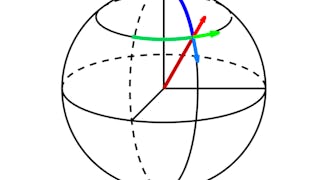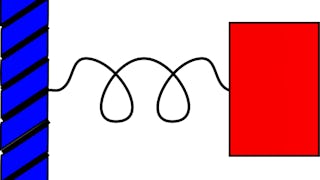This course covers the most important numerical methods that an engineer should know, including root finding, matrix algebra, integration and interpolation, ordinary and partial differential equations. We learn how to use MATLAB to solve numerical problems, and access to MATLAB online and the MATLAB grader is given to all students who enroll.

Gain next-level skills with Coursera Plus for $199 (regularly $399). Save now.

Numerical Methods for Engineers
This course is part of Mathematics for Engineers Specialization

Instructor: Jeffrey R. Chasnov
Top Instructor
29,743 already enrolled
Included with
(409 reviews)
Recommended experience
What you'll learn
MATLAB and the foundations of scientific computing
Root finding methods such as Newton's method, and numerical linear algebra using the LU decomposition
Integration methods such as adaptive quadrature, and interpolation algorithms using a cubic spline
Numerical methods for solving ODEs, such as Runge-Kutta, and the finite difference method for solving PDEs
Skills you'll gain
- Integral Calculus
- Scripting
- Estimation
- Simulations
- Engineering Analysis
- Mathematical Software
- Plot (Graphics)
- Applied Mathematics
- Scientific Visualization
- Simulation and Simulation Software
- Programming Principles
- Differential Equations
- Algorithms
- Calculus
- Engineering Calculations
- Linear Algebra
- Computational Thinking
- Matlab
- Numerical Analysis
- Mathematical Modeling
Details to know

Add to your LinkedIn profile
8 assignments
See how employees at top companies are mastering in-demand skills

Build your subject-matter expertise
- Learn new concepts from industry experts
- Gain a foundational understanding of a subject or tool
- Develop job-relevant skills with hands-on projects
- Earn a shareable career certificate

There are 6 modules in this course
MATLAB is a high-level programming language extensively utilized by engineers for numerical computation and visualization. We will learn the basics of MATLAB: how real numbers are represented in double precision; how to perform arithmetic with MATLAB; how to use scripts and functions; how to represent vectors and matrices; how to draw line plots; and how to use logical variables, conditional statements, for loops and while loops. For your programming project, you will write a MATLAB code to compute the bifurcation diagram for the logistic map.
What's included
14 videos14 readings2 assignments9 app items
Root finding is a numerical technique used to determine the roots, or zeros, of a given function. We will explore several root-finding methods, including the Bisection method, Newton's method, and the Secant method. We will also derive the order of convergence for these methods. Additionally, we will demonstrate how to compute the Newton fractal using Newton's method in MATLAB, and discuss MATLAB functions that can be used to find roots. For your programming project, you will write a MATLAB code using Newton's method to compute the Feigenbaum delta from the bifurcation diagram for the logistic map.
What's included
12 videos8 readings1 assignment3 app items1 plugin
Numerical linear algebra is the term used for matrix algebra performed on a computer. When conducting Gaussian elimination with large matrices, round-off errors may compromise the computation. These errors can be mitigated using the method of partial pivoting, which involves row interchanges before each elimination step. The LU decomposition algorithm must then incorporate permutation matrices. We will also discuss operation counts and the big-Oh notation for predicting the increase in computational time with larger problem sizes. We will show how to count the number of required operations for Gaussian elimination, forward substitution, and backward substitution. We will explain the power method for computing the largest eigenvalue of a matrix. Finally, we will show how to use Gaussian elimination to solve a system of nonlinear differential equations using Newton's method. For your programming project, you will write a MATLAB code that applies Newton's method to the Lorenz equations.
What's included
13 videos10 readings1 assignment4 app items
The computation of definite integrals is known as quadrature. We will explore the fundamentals of quadrature, including elementary formulas for the Trapezoidal rule and Simpson’s rule; development of composite integration rules; an introduction to Gaussian quadrature; construction of an adaptive quadrature routine where the software determines the appropriate integration step size; and the usage of the MATLAB function integral.m. Additionally, we will learn about interpolation. A good interpolation routine can estimate function values at intermediate sample points. We will learn about linear interpolation, commonly employed for plotting data with numerous points; and cubic spline interpolation, used when data points are sparse. For your programming project, you will write a MATLAB code to compute the zeros of a Bessel function. This task requires the combination of both quadrature and root-finding routines.
What's included
13 videos11 readings1 assignment3 app items
We will learn about the numerical integration of ordinary differential equations (ODEs). We will introduce the Euler method, a single-step, first-order method, and the Runge-Kutta methods, which extend the Euler method to multiple steps and higher order, allowing for larger time steps. We will show how to construct a family of second-order Runge-Kutta methods, discuss the widely-used fourth-order Runge-Kutta method, and adopt these methods for solving systems of ODEs. We will show how to use the MATLAB function ode45.m, and how to solve a two-point boundary value ODE using the shooting method. For your programming project, you will conduct a numerical simulation of the gravitational two-body problem.
What's included
13 videos9 readings1 assignment3 app items
We will learn how to solve partial differential equations (PDEs). While this is a vast topic with various specialized solution methods, such as those found in computational fluid dynamics, we will provide a basic introduction to the subject. We will categorize PDE solutions into boundary value problems and initial value problems. We will then apply the finite difference method for solving PDEs. We will solve the Laplace equation, a boundary value problem, using two methods: a direct method via Gaussian elimination; and an iterative method, where the solution is approached asymptotically. We will next solve the one-dimensional diffusion equation, an initial value problem, using the Crank-Nicolson method. We will also employ the Von Neumann stability analysis to determine the stability of time-integration schemes. For your programming project, you will solve the two-dimensional diffusion equation using the Crank-Nicolson method.
What's included
17 videos15 readings2 assignments4 app items
Earn a career certificate
Add this credential to your LinkedIn profile, resume, or CV. Share it on social media and in your performance review.
Instructor

Top Instructor
Explore more from Math and Logic
 Status: Preview
Status: PreviewLudwig-Maximilians-Universität München (LMU)
 Status: Free Trial
Status: Free TrialThe Hong Kong University of Science and Technology
 Status: Free Trial
Status: Free TrialThe Hong Kong University of Science and Technology
 Status: Free Trial
Status: Free TrialThe Hong Kong University of Science and Technology
Why people choose Coursera for their career




Learner reviews
409 reviews
- 5 stars
90.73%
- 4 stars
7.07%
- 3 stars
0.97%
- 2 stars
0.48%
- 1 star
0.73%
Showing 3 of 409
Reviewed on Jul 17, 2023
Hello, thank you for your efforts in the course. It was very useful and beautiful. I hope you will always be healthy and happy. Mohammad Pakzad from Iran.
Reviewed on Jan 2, 2023
very Fantastic core course for all engineering and science students to take. Many thanks again to Prof. Jeffrey Chasnov and everyone for making this happen. God bless you.  
Reviewed on May 18, 2023
I have been impressed by this course. Now I am well-equipped for tackling all complex problems. Thank you is not enough!
Frequently asked questions
To access the course materials, assignments and to earn a Certificate, you will need to purchase the Certificate experience when you enroll in a course. You can try a Free Trial instead, or apply for Financial Aid. The course may offer 'Full Course, No Certificate' instead. This option lets you see all course materials, submit required assessments, and get a final grade. This also means that you will not be able to purchase a Certificate experience.
When you enroll in the course, you get access to all of the courses in the Specialization, and you earn a certificate when you complete the work. Your electronic Certificate will be added to your Accomplishments page - from there, you can print your Certificate or add it to your LinkedIn profile.
Yes. In select learning programs, you can apply for financial aid or a scholarship if you can’t afford the enrollment fee. If fin aid or scholarship is available for your learning program selection, you’ll find a link to apply on the description page.
More questions
Financial aid available,





